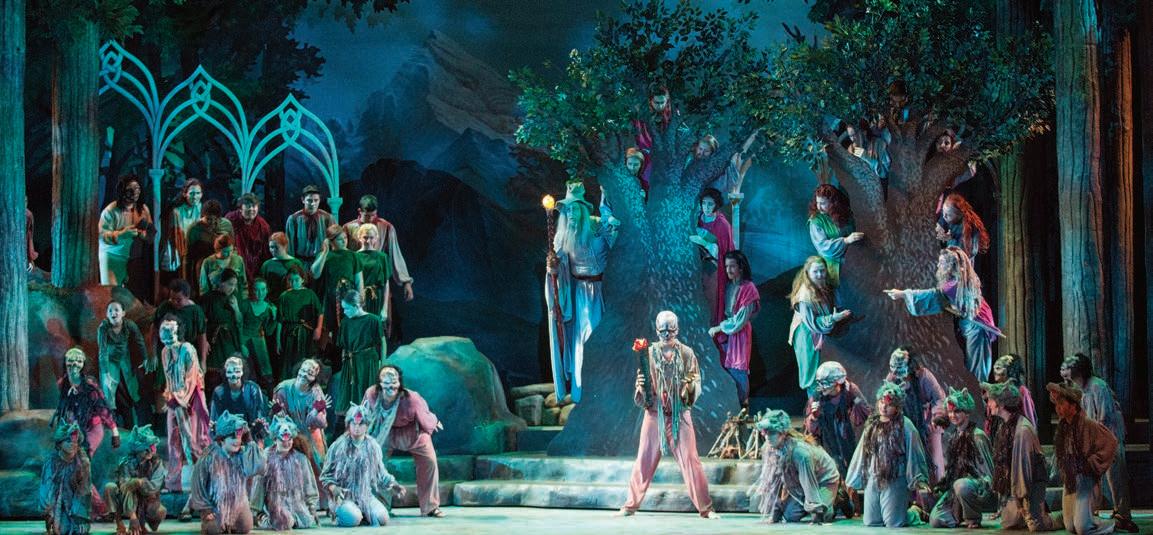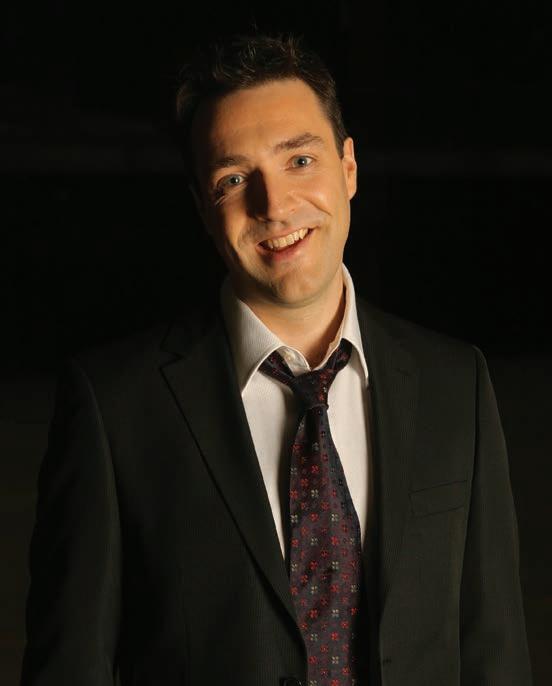
NOVEMBER 9, 10M


NOVEMBER 9, 10M
Music and Libretto By Dean Burry
Opera in Two Acts, Sung in English
Based on the writings of J.R.R. Tolkien
(In Order of Appearance)

CONDUCTOR
Jessé Martins
STAGE DIRECTOR
Martha Collins
SCENIC DESIGNER
Jeffrey W. Dean
COSTUME DESIGNER
B. G. FitzGerald
LIGHTING DESIGNER
Ken Yunker
HAIR AND MAKE-UP DESIGNER
Sue Schaefer
ASSISTANT CONDUCTOR
Arthur Bosarge
OLD BILBO BAGGINS
Jake Stamatis*
LANTHIRLIND, an Elf Maiden
Chidinma Smarty
GWELULIND, an Elf Maiden
Makenna Mamazza
AMARLIND, an Elf Maiden
Nikolina Šupe
LASSLIND, an Elf Maiden
Briana Wadsworth
GALLIND, an Elf Maiden
JoAnna Pope*
NAURLIND, an Elf Maiden
Vittoria Morales-Franco
BILBO BAGGINS, a Hobbit
Isabella Maltese
GANDALF, a Wizard
Luke Harnish*
THORIN, Leader of the Dwarves
Giuliana Bordes
DWALIN, a Dwarf
Abril Sanchez-Rodriguez
BALIN, a Dwarf
Ara Martinez
FILI, a Dwarf
Alexis Herman
KILI, a Dwarf
Anjou Burkmier
ORI, a Dwarf
Yaëlle Katz
NORI, a Dwarf
Mia Trainor
DORI, a Dwarf
Sophie Lunsfod
OIN, a Dwarf
Kai Casey
GLOIN, a Dwarf
Dylan Murphy
BIFUR, a Dwarf
Olivia Novak
BOFUR, a Dwarf
Dylan Alan
BOMBUR, a Dwarf
Balthazar O’Neil
ELROND, an Elf-Lord
Finn MacBeth
AZOG, the Great Goblin
Zane Hancock
BOLG, a Goblin
Jalil Campbell
GOLLUM, a Goblin
Alexia Pino-Delgado
EAGLE
Chindinma Smarty
EAGLE LORD
Makenna Mamazza
BARD THE BOWMAN
Eitan Katz
MAYOR OF LAKETOWN
Natalie Purmort
THRUSH
Nikolina Šupe
SMAUG, a Dragon
Luke Harnish*
* Sarasota Opera Resident Artist
The Hobbit Orchestra
Chorus: Sarasota Youth Opera
Youth Opera Production sponsored by the Les and Carol Brualdi Foundation

The Future, Third Age, 3018: A meeting hall in the Elvish town of Rivendell
Bilbo Baggins, a hobbit, has been called before the Council of Elrond to tell the story of how he acquired ‘The Ring’.
The Present, Third Age, 2941
The wizard Gandalf has come to Hobbiton to convince Bilbo to join in an adventure. Bilbo refuses, but the next day Gandalf arrives at Bilbo’s accompanied by a group of dwarves. They explain their plan to go to the Misty Mountains to reclaim Thorin’s throne and treasures, which were stolen by the dragon Smaug. Bilbo agrees to be their ‘burglar’.
On their journey they stop at the Elvish sanctuary of Rivendell. The Elf Lord Elrond explains that the swords the dwarves had found are special and will glow blue to warn when they are near goblins.
Upon leaving Rivendell a storm forces the group to seek refuge in a cave where they are attacked by goblins. They are brought before Azog, the goblin leader who is enraged to discover the swords in the group’s possession. Gandalf creates a diversion so the dwarves can escape, and Bilbo is separated from the others.
While lost, Bilbo discovers the ring. Unaware of its significance, he pockets it as Gollum appears to challenge him to a contest of riddles. Gollum becomes furious when he is unable to answer Bilbo’s final riddle, but Bilbo puts on the ring which magically makes him invisible, and he escapes.
The travelers are searching for Bilbo when he takes off the ring and suddenly appears. Their reunion is cut short when they are forced to escape a group of wargs and goblins. Ultimately, they are saved by eagles who carry them to safety. Gandalf says he must temporarily leave them, warning them not to stray from the path. When they do, they are attacked by spiders. Bilbo eludes them by using the ring and frees his comrades.
Wood-elves appear and their leader, Thrandruil, questions their presence in his woods. Thorin and the group are arrested, but not before Bilbo again uses the ring to steal a set of keys from the guards. They then escape down the river hidden in barrels.
The group arrives in the village of Laketown. When the villagers learn Thorin has come to reclaim his throne, they rejoice and wish them well as the travellers continue on their way to confront the dragon.
Bilbo enters Smaug’s lair wearing the ring, and Smaug is enraged that he can smell but not see Bilbo. When the dragon learns the dwarves have come for revenge, he leaves to set Laketown ablaze. Bilbo tells the dwarves that Smaug has a weak spot on his scaly skin. The news is taken by the bird Thrush to Bard the Bowman who slays the dragon.
Angry over the destruction of Laketown, Bard leads the villagers and wood-elves to confront Thorin and claim their share of the treasure. Thorin refuses to accept their demands as Thrush warns of an approaching army of goblins and wargs. The epic battle of five armies ensues.
At daybreak Gandalf arrives and discovers Bilbo has survived. They bid farewell to Thorin, who has been mortally wounded, and begin the journey home.
DEAN BURRY COMPOSER/LIBRETTIST
Composer and librettist Dean Burry has become one of the world’s leading composers of children’s opera, his works receiving performances across Canada, the United States, Europe, China and Brazil. At over 600 performances, his opera The Brothers Grimm is one of the most produced operas of the twenty-first century and his operatic adaptation of J.R.R. Tolkien’s The Hobbit, celebrating its 20th anniversary, has been performed throughout the United States and received its European premiere to sold out houses in Ljubljana, Slovenia in 2017. In 2018, Burry accepted a professorship at the DAN School of Drama and Music at Queen’s University in Kingston. He was the Artistic Director of the Canadian Children’s Opera Company from 2015-2017 and is the founding Artistic Director of Kingston’s Watershed Festival - Reimagining Music Theatre.
Recent premieres include the Dora Award winning opera Shanawdithit (Tapestry Opera/Opera on the Avalon), Sea Variations (Canadian Art Song Project), String Quartet No. 1 (New Orford String Quartet) and the opera Il Giudizio di Pigmalione with COSA Canada and Opera McGill. His chamber work The Highwayman was released on the Centrediscs/NAXOS label in October 2023.
Burry was the 2011 recipient of the Ontario Arts Foundation’s Louis Applebaum Composers Award for excellence in the field of music for young people. Following the fall 2022 premiere of Tracing Colville with the Kingston Symphony Orchestra, Burry has begun working on a book which charts not only his own artistic journey, but that of famed Canadian war artist Alex Colville. In September 2024, Tracing Colville was the Canadian representative on a concert celebrating the 80th anniversary of liberation in Nijmegen, the Netherlands.
BY DEAN BURRY
The first time I was handed a faded, dog-eared copy of The Hobbit I was ten. As a young boy I was absorbed in all things fantastical: dragons and giants, Greek and Egyptian mythology, and medieval weapons and warfare. These things are still on the minds of ten years olds, just as they were on the minds of children a thousand years ago. Some things never change, but something about The Hobbit was different. It spoke so convincingly of this ‘made-up’ world, that it seemed real. The story almost seemed more like a history book than just a fantasy novel. Well, I believed.
There was something odd in those pages, however. Little italicized stanzas. Poetry in a novel about vicious goblin wars? While reading, I soon discovered it was not poetry but song lyrics and they were very important. In the tradition of the medieval minstrels and troubadours, Tolkien was constantly

commenting on the story through song. I took piano lessons with the church organist. I was in the recorder ensemble at seven in the morning. I sang “Crawdad Hole” with the grade-six choir at the Kiwanis Festival in Gander, Newfoundland. The Hobbit was full of music. Music and a dragon – my ten-year old idea of heaven.
Being asked to create an opera of The Hobbit has been a chance to fully realize that dream. Of course the book is full of lyrics, but the music must be supplied by the imagination. The music of my opera was inspired by the many races found in the book. Of course, the music must reflect the epic plot, but it must also portray the simple quaintness of the Hobbits, the earthy fortitude of the dwarves, the pastoral lightness of the elves, the mischievous wickedness of the goblins and the arrogance of Smaug the Magnificent.
One of the reasons why Middle Earth is so compelling, is that J.R.R. Tolkien, a language professor at Oxford University in England, was intimately aware of human civilization throughout history. His races behave like real cultures in our own world. Various world musical styles have also flavored the composition of The Hobbit opera. The Dwarvish anthem “Far Over the Misty Mountains” has an undeniable Russian folk-song quality. The Elves of Rivendell sing a song inspired by Renaissance French Madrigals. The Goblins’ harsh and dissonant “Fifteen birds in five fir trees” recalls German expressionism and the fiddle tunes of Hobbiton evoke my own home of Newfoundland. Fantasy grounded in reality means fantasy which feels real. It is something foreign and familiar all at the same time and a great starting point for an engaging piece of theatre.